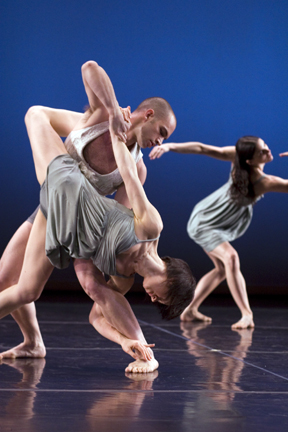Petronio in bloom
Stephen Petronio Company
"Bud Suite," "BLOOM," "The Rite Part"
The Joyce Theater
New York City
April 18, 2006
by Nancy Dalva
copyright ©2006, Nancy Dalva
 From the titles of the two new dances—world premieres both—on his Joyce Theater season, you can deduce that Stephen Petronio intends a progression in these pieces; and a progression is what I see. Looking back not just at this program, but the ones in the years just preceding it, I see the choreographer moving into new territory, and a new investigation of musicality—of a way to make phrases, and thus whole dances, reliant less on his own personal rhythms, and more dependent on outside sources.
From the titles of the two new dances—world premieres both—on his Joyce Theater season, you can deduce that Stephen Petronio intends a progression in these pieces; and a progression is what I see. Looking back not just at this program, but the ones in the years just preceding it, I see the choreographer moving into new territory, and a new investigation of musicality—of a way to make phrases, and thus whole dances, reliant less on his own personal rhythms, and more dependent on outside sources.
These sources are the music of Rufus Wainwright, including an original score made for "BLOOM" in which the composer sets to recordings and a live chorus three poems, two by Walt Whitman ("Unseen Buds" and "One's Self I Sing,") and one by Emily Dickinson ("Hope is the Thing with Feathers.") As it turns out, Wainwright, Whitman, and the Belle of Amherst have nothing in common except Stephen Petronio, which is not quite enough to carry "BLOOM," but it is enough to make it interesting, and wonderfully ambitious, as well. It takes risks. Still, "Bud Suite," to four previous Wainwright recordings, works better—perhaps because there was more time to work with the recorded material, perhaps because the music was selected, rather than commissioned. (That kind of thing is impossible to tweak out from a seat in the audience.)
"Bud Suite" and "BLOOM" find Petronio, who did not dance this season, moving out of an arena in which he was already extremely accomplished—personal solos, and dances expressing his personal, sometimes demonic but always sensitive sensibility and style. These two new works are less perfectly realized than his previous few pieces, more transitional, and more exposed, in the sense that you can see where the work doesn't work, whence before each piece was a silky whole. This is a good thing. Some of the strengths of these pieces include the dynamics in male duets, the compelling solo work of a single female—tall, wonderfully muscular and supple Amanda Wells, and the usual sophisticated Petronio use of stage space. His is a stage of multiple fronts, and multiple activities, all constantly morphing. I noticed a particular attention to finishing details here—the attentive turn of a head or touch of an arm to an extending limb, for instance. Less slip sliding away, more punctuation. What seems missing, to me, is a chemistry among certain dancers. The male-female duets have neither heat nor clinical chilliness, nor even anonymity, nor anomie. Rather, there is just some failure to connect that seems not so much a part of the dance, as a side effect of the dancing. The other quality I found lacking, sometimes, was projection, which may not be called for or even wanted. But some way in would be most welcome. Otherwise, the mind tends to bounce off the work, even as the eye admires it.
 As well it might. All of the dancers are extremely attractive and, as is the way these days, skilled. They are: Thang Dao, Elena Demianenko, Gino Grenek, Davalois Fearon, Jonathan Jaffe, Jimena Paz, Shira Tirabassi and the aforementioned Amanda Wells. The longer they have been dancing with Petronio's company, the better they dance the work, and the more they push out of the sinuous continuity of the choreography and into some kind of unique, yet suitable, expressiveness. This also is a good thing. There are companies where dancers get worse, not better, oddly enough, but this is not one of them.
As well it might. All of the dancers are extremely attractive and, as is the way these days, skilled. They are: Thang Dao, Elena Demianenko, Gino Grenek, Davalois Fearon, Jonathan Jaffe, Jimena Paz, Shira Tirabassi and the aforementioned Amanda Wells. The longer they have been dancing with Petronio's company, the better they dance the work, and the more they push out of the sinuous continuity of the choreography and into some kind of unique, yet suitable, expressiveness. This also is a good thing. There are companies where dancers get worse, not better, oddly enough, but this is not one of them.
The program closed with an excerpt from "The Rite Part," Petronio's take on "The Rite of Spring." It served to show how very far he's progressed in the last 15 years of thoughtful and impassioned work, just as the new pieces showed how very far he is now reaching, and, I hope, will continue to reach. The poems were well chosen. (I would have liked to see him set choreography to the plain spoken word, but I am not a choreographer, nor did he ask my opinion—only it did cross my mind that the music, while giving him a certain structure, worked against the innate rhythms of the texts.) One was about generation and regeneration, one about the "Modern Man," and one about hope. This concert was about all three, and I left it hopeful, myself.
Photos, both by Chris Woltmann
First: Elena Demianenko and Jonathan Jaffe-foreground, Jimena Paz in back in “BLOOM."
Second: Shila Tirabassi in "The Rite Part”
Volume 4, No. 16
April 24, 2006
copyright ©2006 Nancy Dalva
www.danceviewtimes.com